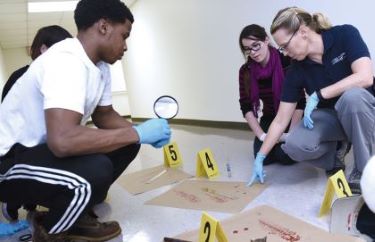
Forensic science technicians aid criminal investigations by collecting and analyzing evidence. Technicians often specialize in either crime scene or laboratory analysis. Forensic science technicians who collect and store evidence from the scene of a crime are sometimes called crime scene technicians. They photograph and document the scene and search for fingerprints or DNA evidence. They must take care to store evidence in a way that preserves its integrity and are responsible for the evidence chain of custody.
Forensic science technicians who work primarily in laboratories use chemicals and specialized equipment to analyze evidence. They also use computers to examine DNA and other evidence collected at crime scenes and match that evidence to people or other known elements, such as vehicles or weapons. Forensic science technicians prepare written reports of their findings and investigative methods. They must be able to explain details from their reports to lawyers, detectives, and other law enforcement officials. In addition, forensic science technicians may be called to testify in court about their findings and methods.
Introduction to Forensic Science provides an overview of the principles, history, and ethics of forensic science. Students learn about the role of forensic scientists in the criminal justice system, the scientific method as applied to forensic investigations, and the various disciplines within forensic science. There are techniques and procedures for processing crime scenes, including evidence collection, documentation, preservation, and chain of custody. They study methods for searching, photographing, sketching, and analyzing physical evidence found at crime scenes.
Criminalistics is the application of scientific principles to the analysis of physical evidence in criminal investigations. This course covers topics such as firearm and toolmark analysis, trace evidence analysis, document examination, and forensic photography. For example, Forensic Biology focuses on the biological aspects of forensic science, including DNA analysis, serology (blood and bodily fluid analysis), and forensic entomology (insect evidence). Students learn about DNA extraction techniques, PCR amplification, gel electrophoresis, and interpretation of DNA profiles.
In forensic chemistry, applicants study chemical analysis of forensic evidence, including toxicology (poison and drug analysis), arson investigation, and trace evidence analysis. They learn about chromatography, spectroscopy, mass spectrometry, and other analytical techniques used to identify and quantify substances. The forensic toxicology course examines the principles and practices of forensic pathology, including the determination of cause and manner of death through autopsy examination. Students learn about postmortem changes, injury analysis, forensic toxicology, and the role of the forensic pathologist in death investigations.
Certified Crime Scene Investigator (CCSI), from the International Association for Identification (IAI) signifies proficiency in various aspects of crime scene investigation, including evidence recognition, collection, preservation, and documentation. It demonstrates competency in applying scientific methods to analyze crime scenes and gather crucial evidence for criminal investigations.
| Certificate | Skills Required | Exam to be Taken |
| Criminal Investigator (CCI) | Criminal law, investigative techniques, evidence handling | CCI Certification Exam by the American College of Forensic Examiners Institute (ACFEI) |
| Fraud Examiner (CFE) | Fraud prevention, fraud detection, financial transactions | CFE Exam by the Association of Certified Fraud Examiners (ACFE) |
| Forensic Interviewer (CFI) | Interview techniques, interrogation, behavioral analysis | CFI Exam by the International Association of Interviewers (IAI) |
| Crime Scene Investigator (CSI) | Evidence collection, crime scene management, forensic science | CSI Certification Exam by the International Association for Identification (IAI) |
| Homicide (CHI) | Investigation techniques, forensic pathology, case management | CHI Certification Exam by the American Board of Criminalistics (ABC) |
| Cyber Crime Investigator (CCCI) | Cryptographic investigation, digital forensics, network security | CCCI Certification Exam by the International Association of Computer Investigative Specialists (IACIS) |
Certified Latent Print Examiner (CLPE) certification recognizes individuals who have demonstrated expertise in the examination, comparison, and identification of latent fingerprints. It signifies proficiency in using various techniques and technologies to analyze latent prints and match them to known individuals or databases.
Certified Fire Investigator (CFI) certification, available through organizations such as the International Association of Arson Investigators (IAAI), validates competency in investigating fires and explosions to determine their cause, origin, and circumstances. It covers fire dynamics, arson investigation techniques, evidence collection, and legal considerations related to fire investigations.
Crime scene analyst Matthew Steiner shows WIRED staff writer Louise Matsakis how to lift fingerprints off a variety of different surfaces.
Crime scene photography is used to record evidence of a crime. Learn what crime scene photography is used for.
How forensic investigators gather evidence to solve crimes. Together with a forensic specialist, we will solve a case, based only on microscopic clues.
This video explains investigative forensic science. Even though the first test is only a presumptive test for blood, it does show that two stain extracts were commingled.
Study the techniques that forensics experts use to analyse sophisticated crime scenes, piecing together evidence to create links between events and persons of interest.
Attending college offers benefits beyond academic learning. Students are exposed to diverse perspectives that challenge their thinking. This fosters problem-solving and communication. College is also about social skills. Whether through student organizations or sports teams, students develop leadership skills and build lasting friendships.
This website is not affiliated with any educational institution, and all trademarks are the exclusive property of the respective owners. All copyrighted works on this website are offered for educational purposes only, governed by the four-factor rule, section 107 of the Copyright Act. CampusInspector.com is the work of a group of students in Bangkok, using data from the US Department of Education, Postsecondary Education Data System (IPEDS). If any information is incorrect, please contact us with updates.